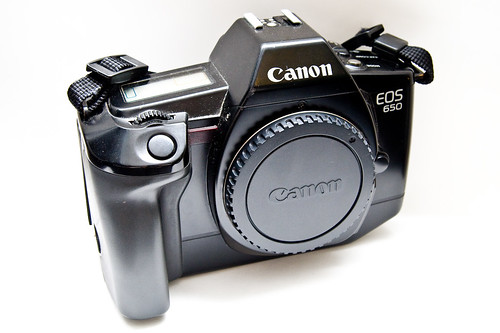Canon EOS 650

|
| Canon EOS 650 image by Rolf F. (Image rights) |
The Canon EOS 650 was introduced in 1987. It was the first EOS (electro-optical system) camera, ushering in an era in Canon SLR's that outlived the end of the film era and took the DSLR market by force, a line which is still going strong into the era of mirror-less digital system cameras, some of which now bear the EOS brand as well.
The 650 was a brand new auto-focus system camera, one that was not based on a previous lens mount. With this model, Canon essentially abandoned their manual focus FD camera systems that had been introduced in the 1970's. The EOS was, from the beginning, a full camera system with fast, hands-free auto-focus. The first EF lenses were noticeably lighter than previous auto-focus lenses, and were in fact lighter than many equivalent manual-focus lenses, due to the materials used in their construction. In manual mode, the lenses focus smoothly, with no feeling of turning gears, as the AF-MF switch mechanically disengages the focusing ring from the auto-focus gearing.
The EOS system is built around the EF lens mount. The initialism stands for either Electronic Focus or electrofocus, depending on whom you ask.
The 650 has a full range of shooting modes: Programmed auto-exposure, shutter priority (both as found on most previous Canon SLR's), aperture priority, depth-of-field priority (an advanced mode that allows the photographer to set a specific distance range to be in focus, thus setting shutter, aperture and auto-focus simultaneously) as well as fully manual exposure.
The shutter is a electronic, vertical metal focal plane capable of 30 sec to 1/2,000 as well as 1/125s with flash. The camera is powered by 2CR5 lithium battery rated for up to 100 36 exp. rolls.
Links
| Japan Camera Grand Prix | |
|---|---|
| Camera of the year
1984: Nikon FA | 1985: Minolta α-7000 | 1986: Canon T90 | 1987: Canon EOS 650 | 1988: Kyocera Samurai | 1989: Nikon F4 | 1990: Canon EOS 10 | 1991: Contax RTS III | 1992: Pentax Z-1 | 1993: Canon EOS 5 | 1994: Minolta α-707si | 1995: Contax G1 | 1996: Minolta TC-1 | 1997: Nikon F5 | 1998: Pentax 645N | 1999: Minolta α-9 | 2000: Canon EOS-1V | 2001: Minolta α-7 | 2002: Canon EOS-1D | 2003: Canon EOS-1Ds | 2004: Nikon D70 | 2005: Konica Minolta α-7 Digital | 2006: Nikon D200 | 2007: Pentax K10D | 2008: Nikon D3 | 2009: Canon EOS 5D Mark II | 2010: Olympus Pen E-P1 | 2011: Pentax 645D | 2012: Nikon D800 | 2013: Sony DSC-RX1 | 2014: Nikon Df | 2015: Canon EOS 7D Mark II | 2016: Sony α7R II | 2017: Olympus OM-D E-M1 Mark II | 2018: Sony α9 | 2019: Lumix S1R | 2020: Sony α7R IV | 2021: Sony α1 | 2022: Nikon Z9 | 2023: Sony α7R V Special Prize Editor | |